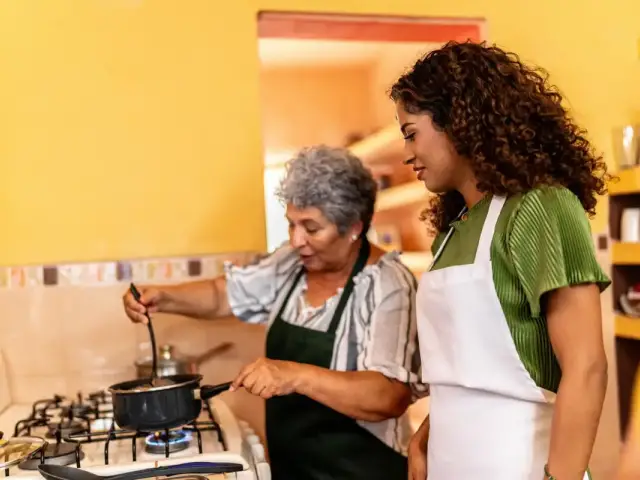Food is more than sustenance. Whether cooking at home or sharing a meal with others, I’ve learned that food can be a powerful pathway to greater well-being.
Yet for many years, I’ve observed that food, particularly cooking, occupies a paradoxical space. On one hand, we romanticize cooking as a wholesome, nourishing activity. On the other, we view it as an unwelcome chore, just one more burdensome demand in a high-stress, fast-paced society. This tension often reflects deeper issues surrounding time, skill, gender roles, and self-care.
With these complexities in mind, I wondered, can we intentionally engage in home cooking and shared meals to foster well-being, especially during times of stress and uncertainty? Here’s what research says about the benefits of cooking and sharing food for our Mental health and relationships.
Allowing time to flow in the kitchen
X

One of the biggest obstacles to home cooking is time. Simultaneously, it also has an amazing ability to reshape our experience of time. When we’re fully immersed in the process—chopping, stirring, seasoning, tasting—we can enter a state of deep focus.
This state, often called flow, is a psychological phenomenon coined by Mihály Csíkszentmihályi. Flow occurs when you’re completely engaged in a challenging yet manageable activity, allowing you to lose track of time in the most satisfying way.
Scientific studies have observed this happen in the kitchen. For example, during the COVID-19 lockdown, one of the most stressful periods in recent memory, researchers found that people experienced flow while cooking. Survey respondents reported that time seemed to pass quickly and pleasantly as they prepared meals. The sensory aspects of cooking—handling ingredients, inhaling aromas, and seeing the final dish—were described as both enjoyable and grounding. Cooking, in this context, became a powerful tool for reducing boredom, relieving stress, and promoting mental well-being during a time of isolation.
Flow states are also studied in professional kitchens, often depicted as high-pressure environments. Take The Bear, a popular Hulu series following a young chef who leaves the world of fine dining to run his family’s chaotic takeout restaurant. Commercial kitchens, as portrayed in the show, often involve long hours, constant pressure, and little recognition, which can lead to burnout from physical exhaustion.
Despite this, researchers investigating flow among professional chefs found that those who regularly experienced it were more satisfied with their jobs and happier. A study of 412 professional cooks in Istanbul revealed that flow states, when present, were good for well-being. However, the study also highlighted obstacles to flow, including poor working conditions, excessive stress, and lack of feedback. The researchers suggest that better workplace environments—where chefs are supported and able to use their skills—can foster not just productivity, but also mental wellness.
These insights aren’t limited to professional chefs. Home cooking can be stressful, too, especially when time is short or distractions are many. Yet, as in a commercial kitchen, flow is possible at home. You might experience it when trying a new recipe that matches your skills, preparing a favorite dish, or simply finding a steady rhythm as you cook. A supportive environment, whether from others or from your own mindset, can enhance this experience, making cooking a more engaging and fulfilling activity.
Empowerment through culinary autonomy and control
Home cooking is also an act of empowerment. It can provide control over ingredients, nurture positive emotions like pride and confidence, and help build a sense of autonomy. Picture the moment you take the first bite of a dish you’ve just prepared. The scent fills the kitchen, the taste is just right, and a sense of pride swells within because you created something nourishing with your own hands.
During the COVID-19 pandemic, this sense of control became especially important. With concerns about food safety and virus transmission, many people turned to home cooking instead of takeout meals to manage what they ate. One study highlighted how this shift helped reduce anxiety around contamination while also fostering creativity, skill-building, and a growing sense of accomplishment.
Home cooking also plays a crucial role in managing chronic health conditions like diabetes, high blood pressure, or heart disease. Nutrition training has historically been very limited in medical school, but more schools and nonprofits are introducing culinary education for medical students and professionals, referred to as culinary medicine.
The impact is profound. Medical students who participate in these hands-on courses don’t just learn nutritional facts—they cook, taste, and understand food in a deeply personal way. This experiential learning builds a sense of self-efficacy, making them more confident in both the kitchen and their clinical practice. Hopefully, this kind of education can also help physicians give better food-related advice so their patients can feel more in control of their health.
Other research has examined how cooking affects those struggling with Mental health. In psychiatric inpatient wards, cooking workshops have been found to improve mood among patients with depression, reducing sadness, hopelessness, and fatigue. Patients with eating disorders had more mixed responses, highlighting the complexity of their relationship with food. Still, the findings support the integration of cooking into Mental health treatment as a practical, therapeutic tool that can help foster positive emotions like pride and a sense of achievement.
Strengthening social bonds: Cooking and eating together
Even if cooking isn’t your thing, there are still powerful benefits to eating meals at home, especially when they’re shared. Eating together is one of the most fundamental ways we connect as humans. Picture laughter around a shared dish, stories passed across the table, and the quiet comfort of knowing someone is there.
New global data from the 2025 World Happiness Report and Gallup surveys reveal just how meaningful shared meals can be. Across 142 countries, people who regularly eat with others report feeling happier, more supported, and less lonely. The positive impact of shared meals rivals that of having a steady job or income. Whether it’s a busy weeknight dinner, a lunch with a friend, or a long Sunday breakfast, eating together nourishes more than our bodies—it strengthens our bonds.
The data also reveal global differences. In Latin America and the Caribbean, people share about nine meals a week. In South Asia, solo dining is more common. In the U.S., solo dining has increased significantly. One in four Americans ate every meal alone on a single day in 2023, a 53% increase since 2003. Younger people and women appear especially affected, reporting higher stress and negative emotions when eating alone.
What’s striking is that even sharing one meal a week with someone else can improve well-being. People who eat with others not only report greater happiness but also enjoy their food more. This underscores that shared meals are not just nice traditions; they’re measurable contributors to mental and emotional health.
A recent study looked at not just quantity but quality of meals shared. When researchers surveyed over 500 U.S. parents about family mealtime during the pandemic, approximately 60% reported eating dinner together more frequently. To measure how much laughter, gratitude, and meaningful connection happened during meals, the researchers created the Family Dinner Quality Scale, assessing everything from shared meal prep and conversation to conflict and screen use at the table. They found that nearly 60% reported positive emotional interactions and 65% felt an increased sense of family support.
One novel finding was the rise of remote dinners. Imagine grandparents joining via Zoom, cousins laughing through a tablet propped up between the salt and pepper. Nearly 70% of families began hosting virtual meals during lockdowns, and 83% planned to continue even after restrictions were lifted. This trend suggests that the essence of family dinners isn’t about physical presence, but about connection—however it’s created.
Of course, more time at the table didn’t always mean harmony. Some families experienced more arguments or screen distractions. But overwhelmingly, the shared laughter and heartfelt talks outweighed the negatives. These benefits were seen across all types of households, regardless of income, race, or education, showing the universal power of the dinner table.
Nourishment beyond the plate
In moments of stress, uncertainty, or disconnection, cooking and sharing meals offer something more than food. They can offer rhythm when life feels chaotic. They help to foster confidence when we feel powerless. They create a connection when we feel alone. Whether you’re seeking a moment of flow, a sense of control, or simply a warm dish to share with someone else, cooking can be a small but profound act of care.
You don’t need to be a gourmet chef to experience these benefits. You just need a space to cook, a willingness to engage, and someone to share it with—even if that someone is yourself. When approached with intention, food becomes not only a source of nourishment but a quiet act of healing—one meal, one moment, one connection at a time.













